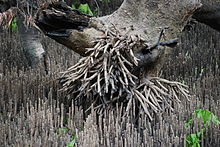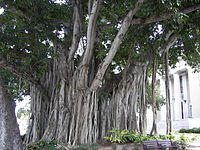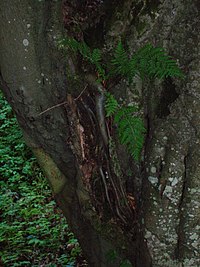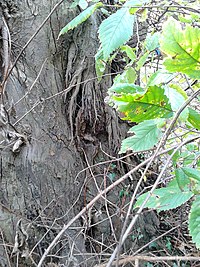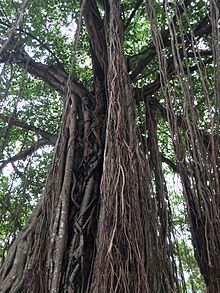
In vascular plants, the roots are the organs of a plant that are modified to provide anchorage for the plant and take in water and nutrients into the plant body, which allows plants to grow taller and faster. They are most often below the surface of the soil, but roots can also be aerial or aerating, that is, growing up above the ground or especially above water.

An epiphyte is a plant or plant-like organism that grows on the surface of another plant and derives its moisture and nutrients from the air, rain, water or from debris accumulating around it. The plants on which epiphytes grow are called phorophytes. Epiphytes take part in nutrient cycles and add to both the diversity and biomass of the ecosystem in which they occur, like any other organism. They are an important source of food for many species. Typically, the older parts of a plant will have more epiphytes growing on them. Epiphytes differ from parasites in that they grow on other plants for physical support and do not necessarily affect the host negatively. An organism that grows on another organism that is not a plant may be called an epibiont. Epiphytes are usually found in the temperate zone or in the tropics. Epiphyte species make good houseplants due to their minimal water and soil requirements. Epiphytes provide a rich and diverse habitat for other organisms including animals, fungi, bacteria, and myxomycetes.

A banyan, also spelled banian, is a fig that develops accessory trunks from adjacent prop roots, allowing the tree to spread outwards indefinitely. This distinguishes banyans from other trees with a strangler habit that begin life as an epiphyte, i.e. a plant that grows on another plant, when its seed germinates in a crack or crevice of a host tree or edifice. "Banyan" often specifically denotes Ficus benghalensis, which is the national tree of India, though the name has also been generalized to denominate all figs that share a common life cycle and used systematically in taxonomy to denominate the subgenus Urostigma.

Ficus benghalensis, or Ficus indica commonly known as the banyan, banyan fig and Indian banyan, is a tree native to the Indian Subcontinent. Specimens in India are among the largest trees in the world by canopy coverage. It is also known as the "strangler fig" because it starts out as epiphyte, that is, leaning on another tree that it ends up suffocating.

Ficus benjamina, commonly known as weeping fig, benjamin fig or ficus tree, and often sold in stores as just ficus, is a species of flowering plant in the family Moraceae, native to Asia and Australia. It is the official tree of Bangkok. The species is also naturalized in the West Indies and in the states of Florida and Arizona in the United States. It is one of the most common trees in Israeli cities and parks. In its native range, its small fruit are favored by some birds.

A houseplant, sometimes known as a pot plant, potted plant, or an indoor plant, is an ornamental plant that is grown indoors. As such, they are found in places like residences and offices, mainly for decorative purposes. Common houseplants are usually tropical or semi-tropical, and are often epiphytes, succulents or cacti.

Ficus microcarpa, also known as Chinese banyan, Malayan banyan, Indian laurel, curtain fig, or gajumaru (ガジュマル), is a tree in the fig family Moraceae. It is native in a range from China through tropical Asia and the Caroline Islands to Australia. It is widely planted as a shade tree and frequently misidentified as F. retusa or as F. nitida.

Strangler fig is the common name for a number of tropical and subtropical plant species in the genus Ficus, including those that are commonly known as banyans.

Ficus citrifolia, also known as the shortleaf fig, giant bearded fig, Jagüey, wild banyantree and Wimba tree, is a species of banyan native to southern Florida, the Caribbean, Mexico, Central America, and northern South America south to Paraguay. It is distinguished from the closely related Florida strangler fig mainly by the finer veining in the leaves.

Ficus elastica, the rubber fig, rubber bush, rubber tree, rubber plant, or Indian rubber bush, Indian rubber tree, is a species of flowering plant in the family Moraceae, native to eastern parts of South and Southeast Asia. It has become naturalized in Sri Lanka, the West Indies, and the US state of Florida. Despite its common names, it is not used in the commercial production of natural rubber.

Curtain Fig Tree is a heritage-listed tree at Curtain Fig Tree Road, Yungaburra, Tablelands Region, Queensland, Australia. It is one of the largest trees in Tropical North Queensland, Australia, and one of the best known attractions on the Atherton Tableland. It was added to the Queensland Heritage Register on 3 December 2009.

Ficus pumila, commonly known as the creeping fig or climbing fig, is a species of flowering plant in the mulberry family, native to East Asia and naturalized in parts of the southeastern and south-central United States. It is also found in cultivation as a houseplant. The Latin specific epithet pumila means "dwarf", and refers to the very small leaves of the plant.
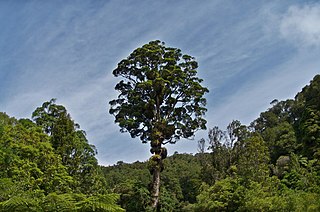
Metrosideros robusta, the northern rātā, is a forest tree endemic to New Zealand. It grows up to 25 metres (82 ft) or taller, and usually begins its life as a hemiepiphyte high in the branches of a mature forest tree; over centuries the young tree sends descending and girdling roots down and around the trunk of its host, eventually forming a massive, frequently hollow pseudotrunk composed of fused roots. In disturbed ground, or where there are gaps in the forest cover, northern rātā will grow on the ground with a normal but short trunk.

Metrosideros fulgens is a forest liana or vine endemic to New Zealand. It occurs in coastal and lowland forest throughout the North Island, on the west coast of the South Island and on the Three Kings Islands north of Cape Reinga. It is one of a number of New Zealand Metrosideros species which live out their lives as vines, unlike the northern rata (M.robusta), which generally begins as a hemi-epiphyte and grows into a huge tree. Scarlet rātā is one of the better-known species of rātā vines, because it flowers in autumn or winter, and is often highly visible on well-lit host trees along forest roads, with vibrant displays of large red flowers that rise above the forest canopy.
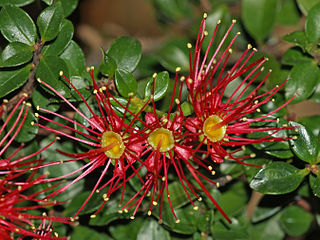
Metrosideros carminea is a forest liane or vine that is endemic to New Zealand. It occurs in coastal and lowland forest from Te Paki in the north of the North Island south to Māhia Peninsula and Taranaki. It is one of a number of New Zealand Metrosideros species which live out their lives as vines, unlike the northern rata (M.robusta), which generally begins as a hemi-epiphyte and grows into a huge tree.

Indoor bonsai are bonsai cultivated for the indoor environment. Traditionally, bonsai are temperate climate trees grown outdoors in containers. Tropical and sub-tropical tree species can be cultivated to grow and thrive indoors, with some suited to bonsai aesthetics shaped as traditional outdoor or wild bonsai.

Ficus aurea, commonly known as the Florida strangler fig, golden fig, or higuerón, is a tree in the family Moraceae that is native to the U.S. state of Florida, the northern and western Caribbean, southern Mexico and Central America south to Panama. The specific epithet aurea was applied by English botanist Thomas Nuttall who described the species in 1846.

The balete tree are several species of trees in the Philippines from the genus Ficus, which are broadly referred to as balete in the local language. A number of these are strangler figs, as they germinate upon other trees, before entrapping their host tree entirely and eventually killing it. Consequently the young plants are hemiepiphytes, i.e. epiphytes or air plants that grow several hanging roots which eventually touch the ground and take root. Some baletes produce natural rubber of an inferior quality. The Indian rubber tree, F. elastica, was formerly cultivated to some extent for rubber. Some of the species like tangisang-bayawak or Ficus variegata are large and could probably be utilized for match wood. The wood of Ficus species are soft, light, and of inferior quality, and the trees usually have ill-formed, short boles.

Sonneratia caseolaris, commonly known as mangrove apple, is a species of plant in the family Lythraceae. The fruit is noted for its outward similarity to the persimmon fruit.

Ficus superba, also known as sea fig or deciduous fig, is a hemiepiphytic tree of genus Ficus. It is one of the species known as banyans or "strangler figs" because of its potential to grow as a hemi-epiphyte and eventually progress to the strangling habit of species in this subgenus. It is, however, not an obligate hemi-epiphyte and can be found growing as single stemmed trees in forests. It is found in Japan, Taiwan, Australia, and China, as well as various parts of Southeast Asia, such as Thailand, Vietnam, Java, Kalimantan, the Lesser Sunda Islands, Moluccas, Seram Island, and Peninsular Malaysia.
